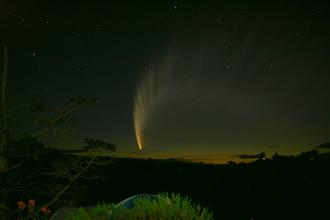Listen to part of a lecture in an astronomy class.
聽一段天文學(xué)課程。
OK. We've been looking at some of the smaller members of our solar system, comets.
我們已經(jīng)講過太陽系中體型較小的成員——彗星。
You already know about the structure of comets.
你們已經(jīng)知道彗星的結(jié)構(gòu)了。
Let's continue our discussion now by talking about orbits, especially those of the so-called periodic-orbit comets.
我們繼續(xù)講講軌道,特別是那些所謂的“周期軌道彗星”。

These are the comets that circle around the Sun pretty regularly.
這些彗星繞太陽規(guī)律性旋轉(zhuǎn)。
They return again and again, predictably, after a certain period of time.
可以預(yù)測的是,它們在一定時間段后會一次又一次地回歸。
That's why we say their orbits are periodic.
這就是為什么我們說(彗星的)軌道是周期性的。
Probably the most famous and brightest of these is Halley's comet.
也許在彗星中,最著名最明亮的就是哈雷彗星了。
Halley's comet comes from far out in the solar system, goes in close to the Sun, and then out again.
哈雷彗星從遠(yuǎn)處進(jìn)入太陽系,接著靠近太陽,然后再離開太陽系。
At its closest approach to the Sun, Halley's comet is about twice as close to the Sun as Earth is.
在最接近太陽時,哈雷彗星與太陽的距離是地日距離的一半。
And at its farthest, it's about thirty-five time farther from the Sun than we are, which puts it out beyond Neptune.
在離太陽最遠(yuǎn)時,哈雷彗星與太陽的距離是地日距離的三十五倍,比海王星還遠(yuǎn)。
Basically, the idea here is that a periodic comet, with its very elongated orbit, just keeps coming back around again and again.
基本上,這種觀點就是,一個沿著延長軌道運轉(zhuǎn)的周期性彗星,會一次又一次回到原處。
With Halley's comet, well, it returns every 75 years, roughly.
對哈雷彗星來說,差不多每七十五年回歸一次。
But where is Halley's comet during most of this time?
但這大部分時間里哈雷彗星都在哪兒呢?
Well, like all orbiting bodies, a comet moves faster when it's closer to the Sun, so it only spends about a year or two in our neighborhood, inside the orbit of Jupiter.
和其它繞軌道運行的星體一樣,彗星在接近太陽時運轉(zhuǎn)較快,所以哈雷彗星只會在我們附近即在木星軌道范圍內(nèi)待一兩年左右,。
Most of its time is spent way out beyond Jupiter's orbit, poking along near the farther reaches of it own orbit.
大部分時間里,哈雷彗星都在木星軌道外,在自己軌道的遠(yuǎn)端流連。
Because of this, we can only see Halley's for a few months every 75 years, first on its way in toward the sun, and then on its way out again.
正因如此,每七十五年,我們也只能在幾個月內(nèi)看見哈雷彗星,先是它靠近太陽的時候,接著是它離開。
Now, you remember from our previous discussion that comet's nucleus, its core, is made up of ice and dust, like frozen snowball.
你們還記得我們先前的討論說過,彗星的核由冰和塵土組成,就像一個冰凍的雪球一樣。
And as it approaches the sun, it starts to heat up.
在它靠近太陽的時候,它開始升溫。
And some of the ice vaporize into gas and spreads out from the nucleus.
一部分冰會蒸發(fā)成氣體,從核部散發(fā)出去。
The gases that vaporize from the comet, the comet never collects them back again, so on every orbit, the comet leaves part of itself behind.
從彗星蒸發(fā)出去的氣體,是無法被彗星回收的,所以每次繞軌運行,彗星都會留下自己的一部分。
OK, how old is this solar system? Four and a half billion years, remember?
太陽系有多少歲了?四十五億年,你們還記得嗎?
And Halley's is going around the sun once every 75 years and losing stuff each time.
哈雷彗星每七十五年就要繞太陽旋轉(zhuǎn)一次,每次都會失去些東西。










